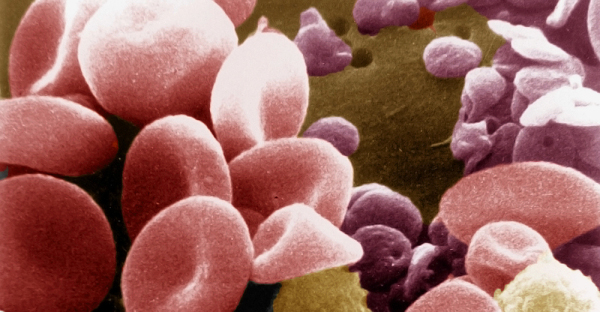Genetic markers for blood clot found

Researchers have uncovered genetic markers found in people at risk of developing potentially fatal blood clots that can lead to heart attack. The team has identified new genes which play a role in controlling the way blood clots form in humans.
The study, published this week in the leading haematology journal Blood, could inform ways of detecting and treating coronary heart disease – the most common form of disease to affect the heart and an important cause of premature death.
The research was carried out as part of the Bloodomics project, which aims to discover novel genes regulating platelets – the tiny cells in the blood that stick together to form a blood clot.
Understanding what makes these cells more sticky in some people than others could provide potential therapeutic targets for treatment of cardiovascular disease.
“We have long known that platelet activity and clot formation varied between different people. But we now have identified some of the genetic reasons for this.”
Professor Alison Goodall from the Department of Cardiovascular Sciences at the University of Leicester and a lead author on the study
The team identified six genes associated with the development of blood clots. They then looked at those genes in 11,500 DNA samples taken both from people who had suffered heart attack and from apparently healthy individuals. Among the six genes, they identified two – called COMMD7 and LRRFIP1 – that were associated with blood clotting and potentially also associated with a risk of heart attack.
“Because of their possible dual association with both blood clotting and heart attack risk, we wanted to investigate these two genes further. So the next step was to look beyond the statistical associations we had identified, to ask what biological processes these genes might be involved in.”
Professor Willem Ouwehand from the University of Cambridge, Honorary Faculty member at the Wellcome Trust Sanger Institute and a lead author on the paper
To better understand their biology, the team looked at the way the genes operate in the zebrafish – an organism which, because of its transparent tissue, provides an excellent window for researchers to look at blood circulation. When the team ‘turned off’ the two genes in the zebrafish, they found a reduction in the number of blood clots developing in the fish.
The results add a layer of biological evidence on top of the statistical associations.
To further pick apart the biology of their discoveries, the team looked at the way that the protein produced by the LRRFIP1 gene interacts with others to exert its effect. Detailed study of these interactions confirmed that the LRRFIP1 protein is a building block of the protein skeleton of platelets in the blood and plays a role in maintaining their cellular structure.
“The genes we identified take us further towards characterising the complex of genetic and environmental factors involved in blood clotting, a key determinant of heart disease and heart attack. Identifying associations of this kind is a small step on the road towards the development of new therapeutics to treat the heart disease patients of the future.
“But much more remains to be done and establishing with certainty the role of these two genes in determining heart attack risk will require additional large scale studies in the future.”
Dr Kate Rice from the Wellcome Trust Sanger Institute and one of the authors on the study
More information
Funding
The Bloodomics project was funded by the 6th Framework Programme of the European Union.
Participating Centres
- Department of Cardiovascular Science, University of Leicester, Clinical Sciences Wing, Glenfield Hospital, Leicester, UK
- Leicester NIHR Biomedical Research Unit in Cardiovascular Disease, Glenfield Hospital, Groby Road, Leicester UK
- Department of Haematology, University of Cambridge and National Health Service Blood and Transplant, Long Road, Cambridge, UK
- Laboratory for Thrombosis Research, IRC KU Leuven Campus Kortrijk, Kortrijk, Belgium
- UCD Conway Institute, School of Biomolecular and Biomedical Science, University College Dublin, Belfield, Dublin, Ireland
- Associazione per lo Studio della Trombosi in Cardiologia, Division of Cardiology, Ospedale Maggiore, University of Parma, Parma, Italy
- European Bioinformatics Institute, Wellcome Trust Genome Campus, Hinxton, Cambridge, UK
- Medical Research Council Biostatistics Unit, Robinson Way, Cambridge, UK
- Human Genetics, Wellcome Trust Sanger Institute, Wellcome Trust Genome Campus, Hinxton, Cambridge, UK
- Sanquin Blood Supply Foundation, Amsterdam, The Netherlands
- Academic Medical Centre of the University of Amsterdam, Department of Vascular Medicine, Academic Medical Center, Meibergdreef, Amsterdam, The Netherlands
Publications:
Selected websites
The Wellcome Trust Sanger Institute
The Wellcome Trust Sanger Institute, which receives the majority of its funding from the Wellcome Trust, was founded in 1992. The Institute is responsible for the completion of the sequence of approximately one-third of the human genome as well as genomes of model organisms and more than 90 pathogen genomes. In October 2006, new funding was awarded by the Wellcome Trust to exploit the wealth of genome data now available to answer important questions about health and disease.
The Wellcome Trust
The Wellcome Trust is a global charitable foundation dedicated to achieving extraordinary improvements in human and animal health. We support the brightest minds in biomedical research and the medical humanities. Our breadth of support includes public engagement, education and the application of research to improve health. We are independent of both political and commercial interests.


